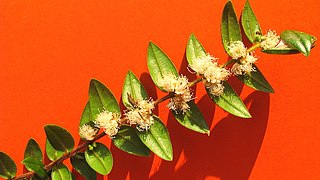
Ugni is a genus of plants in the myrtle family Myrtaceae, described as a genus in 1848. It is native to western Latin America from the Valdivian temperate rain forests of southern Chile and adjacent regions of southern Argentina, north to southern Mexico.

Jabuticaba, also spelled Jaboticaba, is the edible fruit of the jabuticabeira or Brazilian grapetree. The purplish-black, white-pulped fruit grows directly on the trunk of the tree, making it an example of 'cauliflory'. It is eaten raw or used to make jellies, jams, juice or wine. The tree, of the family Myrtaceae, is native to the states of Rio de Janeiro, Minas Gerais, Goiás and São Paulo in Brazil. Related species in the genus Myrciaria, often referred to by the same common names, are native to Brazil, Argentina, Paraguay, Peru and Bolivia.

Myrciaria is a genus of large shrubs and small trees described as a genus in 1856. It is native to Central and South America, Mexico, and the West Indies, with many of the species endemic to Brazil. Common names include hivapuru, sabará, and ybapuru.

Plinia is a genus of flowering plants in the myrtle family, Myrtaceae described by Linnaeus in 1753. It is native to Central and South America as well as the West Indies.
Plinia spirito-santensis, commonly known as jabuticaba peluda de cruz or Grimal in the United States, is a species of plant in the family Myrtaceae. It is endemic to broad-leafed coastal forests, at altitude, in eastern Brazil. The plant is a semideciduous shrub or small tree which can grow to between 3 and 6 metres tall. It produces edible deep reddish-purple berries, up to 30mm in diameter. At the apex of the fruit there is a small cross, from which the name derives.
Plinia phitrantha, commonly known as jaboticaba branca or ibatinga , is a species of plant in the family Myrtaceae. It is endemic to the states of São Paulo and Minas Gerais in south-eastern Brazil. The tree grows to between 2 and 7 metres tall, and produces edible fruit, between 10 and 25mm in diameter, which is green in colour due to a lack of anthocyanins in the skin.
Plinia grandifolia, commonly known as jaboticaba graúda, is a species of plant in the family Myrtaceae. It is endemic to south-eastern Brazil, and is found almost exclusively in the under-story of the Atlantic Rainforest. The tree grows to between 4 and 8 metres tall, and produces dark-purple, edible fruit, between 15 and 25mm in diameter.

Plinia peruviana, commonly known as jabuticaba cabinho in Brazil, is a species of plant in the family Myrtaceae. It is endemic to central, South America.
Plinia coronata, commonly known as jaboticaba coroada, is a species of plant in the family Myrtaceae. It is endemic to south-eastern Brazil. The tree grows to between 4 and 12 metres tall, and produces purple, edible fruit, which is between 25 and 30mm in diameter.
Plinia complanata, is a species of plant in the family Myrtaceae. It was discovered in the coastal forests of São Paulo (state), Brazil and first described in 2002.
Plinia pauciflora, is a species of plant in the family Myrtaceae. It was discovered in the coastal forests of São Paulo (state), Brazil and first described in 2002.
Plinia espinhacensis is a species of plant in the family Myrtaceae. It is endemic to the Espinhaço Mountains in the state of Minas Gerais, Brazil. The tree was first described in 2010 and grows up to 5 metres tall.
Plinia rogersiana is a species of plant in the family Myrtaceae. It is endemic to the state of São Paulo in the south-east of Brazil. It is considered critically endangered, possibly extinct.
Plinia salticola, commonly known as dwarf mulchi or dwarf cambucá, is a species of plant in the family Myrtaceae. The tree is endemic to Costa Rica and Ecuador, grows to between 1 and 1.5 metre tall, and produces edible orange fruits.

Myrciaria strigipes, commonly known as cambucá da praia or cabeludinha da praia, is a species of plant in the family Myrtaceae. It is an evergreen shrub or small tree, endemic to Bahia and Espírito Santo in the east of Brazil. The plant grows up to between 4 and 9 metres tall, and produces edible yellowish fruits between 22 and 28mm in diameter. Consumed raw, the fruit has been described as tasting somewhere between Myrciaria glazioviana and Plinia cauliflora.
Plinia martinellii, commonly known as jabuticabinha da mata, is a species of plant in the family Myrtaceae. It is endemic to the Atlantic Rainforest in the state of Rio de Janeiro, Brazil. This small tree produces dark blue-black fruits, around 20mm in diameter.
Plinia rivularis, commonly known as yva poroity, jaboticabarana, jabúriti, guapuriti, cambucá peixoto, jabuticaba de cacho, or piuna is a species of plant in the family Myrtaceae.
Plinia inflata, commonly known as mulchi in Ecuador or cambucá equatoriano in Brazil, is a species of plant in the family Myrtaceae. The tree is endemic to the Ecuadorian and Brazilian Amazon, grows to between 3 and 4 metres tall, and produces edible yellow-orange fruits. This plant has historically been mistaken for Eugenia subterminalis.
Myrciaria rupestris is a species of plant in the family Myrtaceae. It is endemic to west Cuba. Plinia rubrinervis and Plinia rupestris were transferred to Myrciaria as this single species in 2014.
Myrciaria racemosa is a species of plant in the family Myrtaceae. It is endemic to Ecuador and was first described in 2011. It is a tree that grow to between 18 and 28 meters high, with yellowish-white flowers. It is named after its unusual racemose inflorescence.





